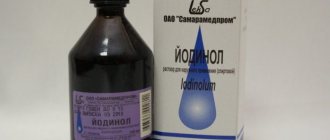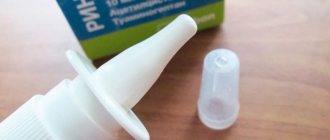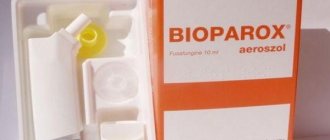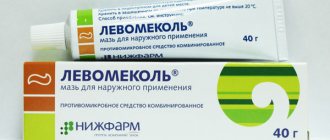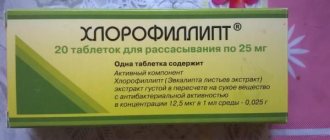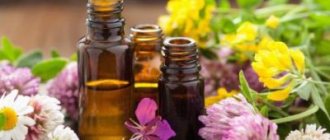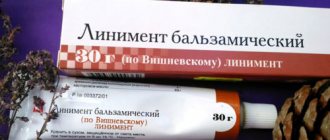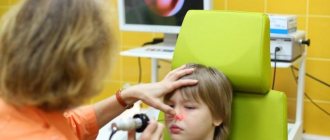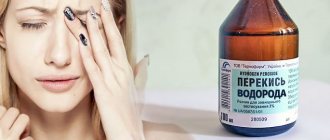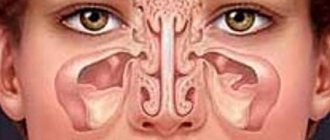Iodinol for a runny nose: how to take it for adults and children?
Never before have so many pharmaceuticals been produced as now.
Previously, people independently prepared remedies that were dripped into the nose to cure sinusitis and get rid of a runny nose. Iodinol was present in many folk recipes used for colds and inflammation of the maxillary sinuses.
The dark liquid replaced sulfonamides, penicillins and antibiotics of other groups, and successfully fought infections in the respiratory tract.
What kind of remedy is this?
Iodinol, which some parents still instill in children with a runny nose on the recommendation of a pediatrician, is sold in any pharmacy in dark glass bottles of 200 or 100, or in plastic bottles with a sprayer with a volume of 25 to 500 ml.
A liter of blue solution contains a gram of molecular iodine. The irritation caused by this active component is reduced thanks to the excipients contained in the liquid in the form of:
- polyvinyl alcohol;
- potassium iodide;
- purified water.
The drug has a negative effect on gram-negative bacteria and gram-positive microorganisms. It is destructive to streptococci, destroys E. coli and harmful fungi.
Upon contact with the skin or mucous membrane, the main component of the solution, which has broken down into active iodine, is sent to the tissues and removed from the body by the kidneys, sweat glands, and through the intestines.
The product loses its healing properties in the sun and decomposes upon contact with alkalis.
Indications for use
For a runny nose, Iodinol can be given to children at least 6 years old, but the dosage must be agreed upon with a pediatrician. The drug is effective for chronic inflammation of the tooth root, palatine and pharyngeal tonsils. Iodinol is prescribed for the treatment of:
- purulent otitis;
- atrophic rhinitis;
- fresh burns;
- infectious skin lesions.
Despite the fact that the blue liquid is considered a safe product, an excess of the active component causes allergies, negatively affects the functioning of the thyroid gland, and can burn the mucous membranes of the mouth or nose. To cure rhinitis in a baby, pediatricians recommend instilling Iodinol solution into the nostrils, but not every child can tolerate the pungent odor.
This antiseptic should not be used:
- for endocrine disorders;
- with Dühring's disease;
- in case of hypersensitivity to the active component.
The drug is not taken orally, but only externally for washing, for applying bandages, as a spray and drops. Gums with stomatitis are treated with a diluted solution of Iodinol.
Side effects
When using an antiseptic externally, the skin becomes irritated, allergies occur, and if there is excessive sensitivity to the components, breathing is impaired. With prolonged exposure to active iodine vapor:
When the drug is taken internally, the pulse quickens, the person suffers from insomnia, and sweats profusely. Iodinol should not be combined with solutions containing ammonia, radioactive isotopes, essential oils, or lithium preparations.
For women who are pregnant or breastfeeding, doctors prescribe this antiseptic only if they cannot do without it. Active iodine can penetrate the placenta and enter milk. In case of hypersensitivity to the components, the drug is replaced with drugs that have a similar effect - Furacilin, Decathylene, Lizak, Malavit.
Features of application
For inflammation of the maxillary sinuses and rhinitis, Iodinol is diluted with cooled boiling water in a ratio of 1 to 4, and if necessary, its concentration is doubled. The resulting product is administered 2 or 3 drops into each nostril. Before the procedure, the nose should be rinsed with saline or sea water. This will clear its cavity of mucus.
You can get rid of a common runny nose using only drops made from Iodinol. For sinusitis, rhinitis with severe symptoms, the drug is used in addition to antibiotics. A tablespoon of liquid should be diluted in a glass of boiling water, cooled to 20–25 degrees.
The nose is washed with the solution, which helps:
- Remove dried crusts.
- Accelerate the removal of exudate.
- Make breathing easier.
To eliminate the symptoms of sinusitis, the drug is used in the form of a spray. Exceeding the dosage can result in irritation of the mucous membranes. Children under 12 years of age are prescribed one injection of Iodinol into the nostril. The procedure is performed three times a day. For adults, four manipulations using the drug per day are enough.
If a runny nose is accompanied by a foul odor, the crusts in the passages are softened with a solution of sea salt. After this, 2 drops of Iodinol are sent into the nasal cavity and pharynx. Do this three times a day. Therapy should be continued for 2 months.
The product cannot be combined with other antiseptics or combined with hydrogen peroxide.
If you follow the doctor's recommendations, Iodinol does not pose a danger to the body of either an adult or a child. Procedures using sprays and drops speed up the treatment of sinusitis and eliminate a runny nose.
Yulia Kalashnik
Source: https://VipLor.ru/preparaty/jodinol-pri-nasmorke
The best and most effective remedies for the treatment of sinusitis
A remedy for sinusitis must be selected that will cope with the symptoms and cause of the disease.
Most often, not one, but several drugs with different spectrum of effects are prescribed: antibiotics, vasoconstrictors and anti-inflammatory drugs, antiallergic and painkillers.
This is necessary to eliminate the negative symptoms that are constant companions of sinusitis:
- headache;
- nasal congestion;
- feeling of pressure in the maxillary sinuses, swelling;
- purulent discharge from the nose;
- weakness;
- drowsiness;
- nervousness;
- prostration;
- difficulty breathing, etc.
Both medications and folk remedies are used against sinusitis; sometimes these two types of therapy are combined for a better and longer-lasting effect.
Drug treatment
Since the cause of sinusitis is bacterial microflora, antibiotics and related medications cannot be used as treatment. They produce remedies for sinusitis in the form of tablets, sprays and drops.
Tablets for sinusitis
Among the most effective remedies for sinusitis, antibacterial drugs come first. They fight directly against the cause of the disease, suppressing the action of bacteria and promoting their removal from the maxillary sinuses.
If the nature of sinusitis is not bacteria, but viruses, then antibiotics will not only be ineffective, but also dangerous to human health, since they will have a suppressive effect on the normal microflora of the body, which will lead to a decrease in immune functions and increased activity of viruses.
The most effective antibiotics are Sinupret, Ceftriaxone, Augmentin, Sumamed, Macropen, Amoxiclav, etc. are also used. They must be taken for at least 3-5 days, combined with other drugs used in the treatment of sinusitis.
A good remedy is Sinupret, which is more effective in particular for a viral infection that provokes sinusitis. Its basis is exclusively herbal ingredients, which allows it to be used by all patients without exception.
Once in the body, it relieves swelling, removes pus and mucus from the maxillary sinuses.
Painkillers are also prescribed for sinusitis or sinusitis, since the pathology is always accompanied by a headache and discomfort in the maxillary sinuses. Such drugs include Aspirin, Spazmalgon, etc. They should be taken according to the instructions or medical recommendations.
Antihistamines Clarotadine and Claritin are prescribed if sinusitis occurs as a result of an allergic reaction. They have minimal side effects, are highly effective and are well tolerated by many people.
A sinusitis remedy that helps thin and remove mucus, such as Mucodin, is a mucolytic drug. It or other similar drugs should be used with caution, since often the effect of this type of medicine is much lower than the possible side effects.
Application of sprays
Sprays for sinusitis are highly effective because they allow you to spray medicinal components directly to the sites of infection.
Bioparox is the best drug used to treat many respiratory diseases caused by pathogenic microflora. It must be used regularly for at least 5 days.
The components of the drug quickly help reduce swelling, remove and prevent bacteria from multiplying, improve breathing, etc.
Vasoconstrictor drugs are also used: Nazivin, Farmazol, etc. They help ease breathing and eliminate nasal congestion. These drugs must be used with caution, as they are quickly addictive and suppress the action of the mucous membrane.
Drug Iodinol
The best remedy for sinusitis, but a little forgotten, is Iodinol, which is essentially an aqueous solution consisting of iodine, potassium iodide and polyvinyl alcohol.
The color of this liquid is similar to well-concentrated blue paint, and the smell of the product is iodine, pronounced.
Iodinol is a powerful antiseptic and anti-inflammatory agent, which, when introduced into the body, can eliminate all symptoms of the disease and take part in metabolic processes.
Iodinol is used to treat a number of diseases, the causative agents of which are:
- mushrooms;
- gram-negative bacteria;
- gram-positive microorganisms.
The drug is very rarely prescribed for sinusitis, although previously it was successfully used to treat various diseases in both adults and children. Iodinol was able not only to cure sinusitis, which tends to be chronic, but also to strengthen the functioning of the mucous membranes of the nasal and maxillary sinuses, as a result of which they had greater resistance to other diseases.
Iodinol is used as a nasal rinse. For this, 1 tbsp. l. The drug is added to 1 glass of clean boiled and cooled water, after which the nose is washed in any convenient way. The dosage can be increased according to the instructions or doctor's prescription. Such washings must be done at least 3 times a day. The course of treatment is 1-2 weeks.
Traditional medicine recipes
On their own, folk remedies for sinusitis do not give very good results, since this disease requires drug therapy to avoid various complications. Decoctions of wild lilac, with the help of which you need to do steam inhalations, are very helpful as such remedies (not recommended for exacerbation of the disease).
Fresh beet juice helps well, which should be dropped into the nose 2 times a day, after diluting with water.
The course of treatment is 5 days.
You can make lotions, drops, and decoctions from bay leaves that are effective against sinusitis of any etiology. The liquid from bay decoction can be used as a stand-alone remedy or mixed with vegetable oil, garlic, etc.
Bee products (honey, propolis, dead bees, wax), garlic, aloe juice, mumiyo, medicinal herbs and essential oils are used as homeopathic remedies for sinusitis.
Hirudotherapy, laundry soap, breathing exercises, etc. are used as non-traditional methods.
Which remedy is most effective for sinusitis is up to each person who has encountered this unpleasant illness to decide. The main thing is to make a timely diagnosis and begin treatment prescribed by a doctor, which will help avoid complications and sinus punctures.
Source: //pneumonija.com/nasopharynx/sinusitis/sredstvo-ot-gajmorita.html
Iodinol for children: for stomatitis, gangina, runny nose, instructions, analogues, price
Iodinol is an antiseptic drug that is effective against fungi, tonsillitis, otitis, chronic stomatitis, periodontitis, treats trophic ulcers and other diseases. The drug is also known as “blue iodine”.
It is a clear liquid with a blue color and a characteristic odor. The main component of this drug is molecular iodine, the composition includes ethyl alcohol. This antiseptic is used for external use only.
The drug should be stored in a dark place, closed, from 1 year to 3 years at above-zero temperatures.
Instructions for use of the drug
Iodinol is for topical use only. Diseases of the nose and throat are the most common reason for purchasing Iodinol. Suitable for gargling; you can use analogues in the form of a spray or ointment. Application for a child is safe and painless.
Examples of diseases for which it is advisable to use the drug:
- Iodinol for stomatitis: you need to take the solution and dilute it with boiled water in a ratio of one to two (1:2). This composition is used to treat the gums, throat, nose and stomatitis lesions using a cotton swab or swab. Dropping the drug into the nose is also very effective.
- Treatment of purulent wounds, inflammation due to sore throat, thermal or chemical burns: use gauze bandages, which are pre-lubricated in a solution with the drug.
- During varicose or trophic ulcers: it is necessary to moisten a gauze bandage and make a compress, treat the site of inflammation. Before applying the medicine, wash the skin area with warm water and soap. The dressing is done once or twice a day. The applied bandage does not need to be changed; it is additionally moistened with a solution of the drug.
- For tonsillitis, stomatitis and other inflammatory processes in the mouth and throat, use Iodinol for rinsing: you need to dilute 15 ml of the drug in a glass of boiled water (200 ml). Rinse and drip the nose until the child or adult recovers or feels better.
- To treat ear diseases, the drug is used as drops. Instill 4-8 drops of Iodinol solution into the ears. They may also prescribe special rinses with a solution of the drug.
- Treatment of chronic rhinitis: use the drug in the form of nasal drops and oral irrigation. Before using the drug, to obtain optimal results, it is necessary to clear the internal crusts from the nose. Nasal irrigation, sprays and gargling are done for two to three months, two to three times a day for children and adults (the dose is reduced for a child).
- Treatment of chronic or acute inflammation, with stomatitis, sore throat, tonsillitis: used for gargling, nasal drops and treatment of tonsils. It is necessary to rinse and smear once every three days. The course of treatment for this disease is 4-5 gargles. Usually 50 ml of the drug is allocated for one procedure. Place 5-8 drops into the nose.
- Iodinol is also used during the treatment of thrush. This medicine helps in eliminating pathogens in various areas of the skin. To effectively treat thrush, it is important to properly make the medication solution. It is necessary to prepare the same proportion of the drug and water, which must be boiled and cooled to room temperature. The solution cannot be added to hot water; the evaporation will destroy the properties of Iodinol. The prepared solution is used for rinsing and removing plaque in the mouth.
From 10 to 15% of adults and children suffer from thrush, but do not notice symptoms, being carriers of the infection. Over 75% of girls, young women, and women have had vaginal thrush at least once in their lives. Approximately half of the women experienced recurrent manifestations of the disease.
If a mother has symptoms of thrush, there is a high chance that the baby will become infected with candidiasis.
How do you know if you have thrush? Only a doctor can give an exact answer to this question and prescribe treatment, but there are a number of symptoms by which you can suspect the disease:
- Candidal stomatitis;
- Intestinal candidiasis;
- Sore throat;
- Inflammation in the mouth;
- Balanoposthitis;
- Vaginal candidiasis;
- Changes in nails in a child or adult.
The drug Iodinol is often used to treat fungal infections. Doctors recommend Iodinol for thrush due to its effectiveness, as well as its low price, which does not hurt the buyer’s pocket.
Contraindications and side effects
Some children and adults experience increased sensitivity and intolerance to iodine in the body; Iodinol is not suitable for them. We need to look for alternative methods of treatment.
The drug should not be used for diseases of the thyroid gland, pulmonary tuberculosis, nephritis, nephrosis, pregnancy, as well as for children from one to five years of age.
Side effects when using Iodinol are not significant.
If the drug is used for external use, effects such as: skin irritation may occur if you use the product infrequently; in other cases, with prolonged use of the drug, it becomes possible to get acne, rhinitis, urticaria may appear, and lacrimation and drooling and Quincke's edema are also possible. Allergic reactions, nervousness, sleep disturbances, excessive sweating, tachycardia and diarrhea may occur.
Analogs
If we compare the entire range of Iodinol’s capabilities, then we cannot find a 100% analogue to it, because the scope of the drug is extremely wide.
Used for thrush, runny nose, pain, stomatitis, sore throat, diluted to rinse the nose and mouth, treat and smear affected areas of the skin and much more.
But you can choose medications depending on the disease. Analogs include such drugs as:
- Lugol is an antiseptic. Used in the treatment of diseases of the throat and oral cavity.
- Malavit eliminates skin problems and diseases of the upper respiratory tract. It is actively used in gynecology and dentistry. Effective in the treatment of stomatitis, relieves itching and pain. Treats burns, wounds, frostbite, hematomas, neuritis, dermatitis, vascular disorders and insect bites.
- Doxycycline is used to treat respiratory tract, sore throat and other ENT diseases.
- Betadine is a 10% medicinal solution that is used in: dentistry, surgery, traumatology, gynecology and ophthalmology. It is used for preventive purposes for wound tissue damage, for rinsing, disinfecting skin, treating ulcers and burns.
- Vitaon is a medicinal product effective for lesions and damage to skin tissue and mucous membranes, for sore throat, for rinsing the mouth and throat, treating burns of various types and degrees of complexity, and treating respiratory diseases.
- Bimmunal fights allergic reactions, works against dysbiosis, stomatitis, intestinal infections, food intoxication.
- Citeal is intended for the treatment of various types of bacterial infections.
- Exasprey can be used for pathologies of the nose and mouth caused by a fungal infection.
- Pharmaseptic is an auxiliary drug that is used in dentistry for rinsing the mouth.
- Boric acid is used to treat dermatitis and otitis.
- Yoddicerin is a good substitute for the treatment of burn wounds and frostbite, and is an adjuvant for stomatitis.
Price
Approximate cost for the medicine: from 10 rubles to 25 rubles per 100 ml of solution. It is possible to purchase a smaller volume, but 100 ml is considered optimal. This amount is enough for the entire course of treatment. The average price for the drug is 16 rubles per 100 ml . Do not forget to check the expiration dates on the packaging so that you always use fresh medicine.
Source: https://LechenieDetej.ru/preparaty/dlya-gorla/jodinol.html
special instructions
The drug should be used only in hospital settings.
Avoid contact of the drug with the eyes. When using Iodinol for rinsing, do not swallow the solution.
Temperatures above 40 °C and light accelerate the breakdown of active iodine. Discoloration of the solution indicates a decrease in the effectiveness of the drug due to the destruction of the complex with the transition of active iodine to iodide ion.
We recommend reading: Sea buckthorn oil: beneficial properties and contraindications: what cures
The diluted solution (should have a dark brown color) cannot be stored for long periods of time.
Treatment of purulent otitis, rhinitis
For purulent otitis media, 5-8 drops of iodinol are instilled into the ear.
Iodinol is used to treat atrophic rhinitis. Before using iodinol, it is necessary to clear the nasal cavity of crusts:
After treatment, the nasal cavity and nasopharynx are irrigated with iodine; for atrophic rhinitis, the procedure is repeated after 2-3 days for 3 months.
The medicine is taken orally after meals; for atherosclerosis, 5-12 drops are added to milk and drunk 1-2 times a day for a month.
Treatment of wounds, burns, ulcers
A gauze pad is moistened with iodine and applied to the surface of the wound. As the solution dries, moisten the napkin without removing it.
With this method of wound treatment, a dry crust does not form, the bandage does not stick to the skin, and the iodine in iodinol disinfects and heals tissue damage.
Trophic ulcers with varicose veins are also treated with iodinol. To do this, apply a napkin moistened with the medicine to a previously well-washed and dried wound.
The edges of the ulcer should be lubricated with zinc ointment, and the wound itself can be treated with lime water for a better healing effect.
The compress is bandaged and treatment is continued for 3-5 days. The dressing is done 2 times a day, all this time the bandage is moistened with iodine. If pus is released, change the bandage more often.
Trophic ulcers with varicose veins are also treated with iodinol. To do this, apply a napkin moistened with the medicine to a previously well-washed and dried wound.
Indications for use
It is recommended to use drugs:
- In gynecology: antiseptic surface treatment before surgery
- For infectious and inflammatory lesions of the skin, trauma, myalgia
- For skin ulcerations, chemical and thermal burn wounds (first and second degree)
- For diseases of the ENT organs: stomatitis, tonsillitis, purulent inflammation of the middle ear, chronic tonsillitis or atrophic rhinitis
- For atherosclerosis
- With tertiary syphilis.
Iodinol nasal rinse
Irina
These recommendations are based on many years of practical, puncture-free experience in treating patients with inflammation.
These recommendations are based on many years of practical, puncture-free experience in treating patients with inflammation of the paranasal sinuses, proven recommendations from scientific publications, and experience accumulated in traditional medicine. Recommendations for sinusitis, frontal sinuses, ethmoiditis.
The main tasks of the doctor and the patient in the treatment of diseases of the paranasal sinuses.1. Reducing the inflammatory process in the sinuses (points 1, 2, 3).2. Reducing swelling of the nasal mucosa and sinuses (points 1, 2, 3, 4).3. Improving the outflow of inflammatory secretions from the sinuses (points 3, 4, 5, 6, 7, 8).4.
Reducing inflammation of the mucous membrane in the nasal cavity itself... Read more →
Nara
IF YOU HAVE SINTERITIS?
These recommendations are based on many years of practical, puncture-free experience in treating patients with inflammation of the paranasal sinuses, proven recommendations from scientific publications, and experience accumulated in traditional medicine. Recommendations for sinusitis, frontal sinuses, ethmoiditis.
The main tasks of the doctor and the patient in the treatment of diseases of the paranasal sinuses.1. Reducing the inflammatory process in the sinuses (points 1, 2, 3).2. Reducing swelling of the nasal mucosa and sinuses (points 1, 2, 3, 4).3. Improving the outflow of inflammatory secretions from the sinuses (points 3, 4, 5, 6, 7, 8).4.
Reducing inflammation… Read more →
annoch
NEBULISER THERAPY FOR ACUTE AND CHRONIC RESPIRATORY TRACT DISEASES
NEBULISER THERAPY FOR ACUTE AND CHRONIC DISEASES OF THE RESPIRATORY TRACTMoscow 2006 Valentina Petrovna Dubinina – Candidate of Medical Sciences, head of the phthisiopulmonology office of the Central Clinical Hospital of the Russian Academy of Medical Sciences, corresponding member of the Russian Ecological Academy, pulmonologist, phthisiatrician of the highest category. Reviewer – Doctor of Medicine, Head of the Department of Anesthesia, resuscitation and intensive care Central Research Institute of Tuberculosis of the Russian Academy of Medical Sciences - Yuri Nikolaevich Zhilin. Methodological recommendations. Continue reading →
Evgeniya
Children's first aid kit
This is what I found, it might also be useful to someone. Continue reading →
Childhood diseases from one to three years
Discuss your topic in the community, find out the opinions of active Babyblog users
Go to community
Pharyngitis
Pharyngitis. Description, types, causes, symptoms and treatment of pharyngitis Pharyngitis (lat. Pharyngitis) is inflammation of the mucous membrane and lymphoid tissue of the pharynx. Causes of pharyngitis The main cause of pharyngitis is inhalation of cold or polluted air, the influence of chemical irritations (alcohol, tobacco).
Infectious pharyngitis can be triggered by various microbes (strepto-, staphylo-, pneumococci), as well as viruses (influenza, adenoviruses) and fungi (candida). Pharyngitis often develops as a result of the spread of infection from any source of inflammation adjacent to the pharynx.
This is how pharyngitis develops with sinusitis, rhinitis, dental caries... Read more →
Olga
Cold, treatment? 16th week of pregnancy
Just the other day I announced that even now, with B, I don’t get any colds/drafts, just like before B, like on you... in the morning I woke up, the tonsil on the right hurts, by lunchtime greenery started coming off my nose, I can feel the right ear, the tonsil also hurts, my head/eyes/k….. Continue reading →
Anna
Brief conclusions about the treatment tactics for sore throat
Brief conclusions about the tactics of treating tonsillitis A. Demkin, doctor, St. Petersburg, 2009 Features of antibiotic therapy for acute tonsillitis. Page 21. Not all patients with tonsillitis (acute tonsillitis) require antibiotics 2.
A presumptive or confirmed diagnosis of streptococcal sore throat requires the prescription of antibiotics. 3.
The diagnosis of streptococcal sore throat can be tentatively made by the clinical picture of the disease based on the Centor criteria, and confirmed using microbiological diagnostics or rapid tests such as Strep A. 4.
The main purpose of prescribing antibiotics for streptococcal sore throat is to prevent the development of early and late complications. Antibiotics do not have a significant effect on the timing and severity of clinical manifestations of tonsillitis. 5. The best results (in the absence of intolerance - 90% of all patients) and maximum eradication... Read more →
Ksenia
Well, I ended up on sick leave =(
In general, my fears, despite all the manipulations to get rid of this disgusting cold, were confirmed and I fell ill, but thank God I don’t have a fever, but I have super low blood pressure, a super sore throat and an itching in my nose, in general it’s very unpleasant.
Without hesitation, I immediately went and went on sick leave, now is not the time to neglect my health in favor of work. Well, I will be treated with what my grandmothers treated us with: gargling with iodine and furatsilin, rinsing the nose with saline solution, drinking plenty of fluids and rest...
Continue reading →
Larisa
Treatment through a nebulizer for bronchitis, rhinitis, acute respiratory infections, etc.
Human leukocyte interferon. Interferon is a factor of nonspecific immunity. One of the most important functions of Interferon is to protect cells adjacent to virus-infected cells, preventing the penetration of viruses into a healthy cell. Dosage: the contents of the ampoule are dissolved in 2 ml of distilled water. Inhalation using a nebulizer is carried out 2-4 times a day.
For a course of treatment – 10-15 inhalations. Aminocaproic acid has diverse therapeutic properties, has antiallergic activity, reduces the reproduction of influenza and parainfluenza viruses, and relieves inflammatory edema (Parusov, 1981). Aerosol therapy uses a 5% solution of aminocaproic acid, 2 ml per inhalation 2 times a day for…
Continue reading →
Juicy
Colds during pregnancy
Girls, tell me how to treat? 31st week of pregnancy I got sick, sore throat, runny nose, no fever, periodically lost my voice. The doctor prescribed Lyzobact, nasal rinsing with iodinol, and amoxicillin. I gargle with chamomile and soda, rinse my nose and drink tea with lemon, honey, and jam.
From what the doctor prescribed, I bought Lizobact and Iodinol, read the instructions for amosicillin, where pregnancy is listed as a contraindication. I’ve been sick for a week now, there is practically no improvement, only my runny nose has gone away slightly.
Help me what to do, advise who else is being treated with what? Continue reading →
Catherine
The eldest daughter has a sore throat
We have some kind of nonsense. My daughter rested in the village with her grandmother for a month, there were no obvious problems with her throat and nose... Read more →
Natalia
Got sick:( question about the aspirator.
I didn’t think we would get sick, but dad brought the infection into the house... Neither masks nor moving to another room helped. The throat is red, there is a river of snot, the nose is grunting. No temperature yet.
The doctor prescribed Ruferon in the butt, Laferon in the nose, iodinol, chamomile tea, and nasal rinsing.
And the question is: am I the only one who is so crooked or are you also unable to suck out snot with an aspirator of this type? Continue reading →
Source: //www.BabyBlog.ru/theme/iodinol-promyvanie-nosa
